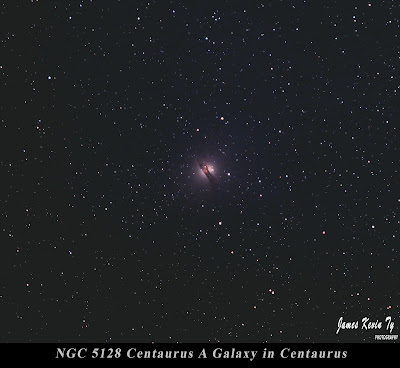The sky this evening is clear so I started to setup early but unfortunately, my northern sky was clouded out so I can't do polar alignment and it was frustrating as the other area of the sky are clear!!! So I missed my plan capture of NGC 2174 Monkey Head Nebula in Orion as it was setting fast in the western horizon :(
I got to do polar alignment past 8:30pm already so opted to start my imaging session to image M46 galactic star cluster in Puppis first and had also a consolation added object inside this tight cluster, NGC 2438 planetary nebula with total exposure of 24 minutes. I then proceed to re image the Leo Triplet Galaxies in Leo which contain NGC 3628, M65 and M66 with a much longer total exposure of 60 minutes.
I then become curious and wondering how the NGC 4039 Antennae Colliding Galaxies would look like so I also spend another 1 hour 45 minutes imaging this small but beautiful pair with an add on extra spiral galaxy NGC 4027 in Corvus.
It was past midnight already that I got carried away from a planned 2hours night imaging into an overnight imaging session as the sky was very clear! I then set my eyes on M51 Whirpool Galaxy in Canes Venatici, this galaxy was extra hard for me to image because I have a very huge Northern building arc that is obstructing my view of the North thus imagine I had to moved my entire rig from my original setup area on our roof deck to the westenmost area for me to image this object! But I'm still happy with the output I got from a short total exposure of 45 minutes because I got obstructed again by our roof deck perimeter fence this time!
I then ended my session with the pair of M16 Eagle Nebula and M17 Swan or Omega Nebula in Serpens with a total exposure of 30 minutes and 20 minutes respectively before I catched up dawn! I hope to give more exposure time for these 2 pairs again in the future.
I also asked myself why should I be complaining as I'm imaging in the light polluted city sky and not in dark skies of Caliraya. Tanay or Nasugbu! :) LOL I used again my Borg 76ED refractor with my Vixen GPDX mount with ASI294 MC Pro for this session.
Monday, April 27, 2020
Wednesday, April 22, 2020
Deep Sky Imaging Session - April 22, 2020
I waited till past midnight before going up our roofdeck to image NGC 6357 Lobster Nebula and NGC 6334 Cat's Paw Nebula in Scorpius using Borg 767ED refractor and Vixen GPDX mount with ASI294 MC Pro. A total exposure of 60 minutes and 45 minutes were made to both objects respectively.
Tuesday, April 21, 2020
Deep Sky Imaging Session - April 21, 2020
After doing an errand to buy some grocery for our home use, i got back home for a very late dinner and saw the sky once again tempting me to image again so after getting some rest, i went up again to our roof deck past midnight and was able to image NGC5139 Omega Centauri globular star cluster in Centaurus which is again positioned very low in the sky less than 30deg SW. I got to expose for around 39 minutes total exposure before I got obstructed :( Afterwards, I try to image M4 , another globular star cluster in Scorpius with a short 24 minutes total exposure only as I had to deal with meridian flip. The last but not the least, one of my favorite deep sky objects, the pair of M8 Lagoon and M20 Triffid Nebula in Sagittarius to wrap up my imaging session with only a total exposure of 24 minutes as dawn catches up with me. I use my old Borg 76ED refractor in tandem with Vixen GPDX mount and ASI294 MC Pro.
Deep Sky Imaging Session - April 20, 2020
Its a good news for me that the weather suddenly starts to clear up once again after almost 2 weeks of bad weather. I try to catch up with the setting NGC 2244 Rosette Nebula in Monoceros which is already setting low in the western horizon. I think the Enhanced Community Quarantine did clean up the sky a bit I was surprised that I was still able to image it and with only less than 20 minutes of total exposure, I'm still quite happy with the result. Afterwards, I try to image the large M67 Galactic star cluster in Cancer with only 27minutes of exposure as well as Leo Triplet Galaxies in Leo consisting of NGC 3628 , M65 and M66 before clouds started to rolled in again! I waited for a while and at around 1:30am, the southern sky opened up a bit for me to image NGC 5128 Centaurus A in Centaurus with a total exposure of 24 minutes before it got obstructed by our building :( After that, I called it a day and so I packed up. Images were taken using my trusty TV-101 refractor on Vixen GPDX mount with ASI294MC Pro.
Tuesday, April 7, 2020
April 8, 2020 Lunar Imaging Session - Super Pink Moon
The sky was almost overcast the whole evening that had me cancelled my deep sky imaging session. But after pass midnight, the sky opens up for a while for me to reimage the biggest Full Moon for 2020 which is fondly called the Super Pink Moon! :) Image taken again using Canon EOS M6 mirrorless camera with Canon EF100-400mm f/4.5-5.6 IS L lens set at 400mm f/11 with exposure of 1/320sec at ISO 400 mounted on Vixen Porta II mount.
April 7, 2020 Lunar Imaging Session - Pink Full Moon
The sky this evening is slightly cloudy after sunset so as I was awaiting darkness to do another deep sky imaging session, I saw the beautiful near Full Moon rising from the Eastern horizon at our roofdeck so I decided to image it using my Canon EOS M6 mirrorless camera with Canon EF100-400mm f/4.5-5.6 IS L lens set at 400mm f/8 mounted on Vixen GPDX mount with a 1/400 sec exposure at ISO 400.
Monday, April 6, 2020
City Deep Sky Imaging Session - April 6, 2020
Another clear sky this evening so I image again and made a challenge myself to try to capture the IC434 Horsehead Nebula without using any narrowband filter near the Full Moon phase which will happen in another 2 days. Although he Moon is further away from IC434, the moon glow is really extreme and I cannot even see NGC 2244 Rosette Nebula except with its internal star cluster only as well as NGC 2174 Monkey Head. Hell Yeah, Am I asking for the Heaven to imsgre them in RGB color??? :) But since I was able to see a faint Flame Nebula, it challenged me to just do it and try exposing for it as I have nothing to lose but get more experience. Well, still was able to capture it faintly by forced image processing of course :) LOL
I was also able to image the Comet C/2019 Y4 Atlas once again and it still exhibit even brighter core and tail despite reports that it has started to disintegrate :(
I also use this opportunity to image Waxing Gibbous Moon before I packed up.
Sunday, April 5, 2020
City Deep Sky Imaging Session - April 5, 2020
I had another clear sky this evening so I change my Canon lens to my very old but trusty TV-101 refractor to again do some practice imaging session to image again the Comet C/2019 Y4 Atlas as well as M35 and M44 Beehive galactic star cluster as the Waxing Gibbous Moon is slightly farther away from the said objects a bit.
Saturday, April 4, 2020
City Deep Sky Imaging Session - April 4, 2020
With the onset of the prolonged Enhanced Community Quarantine (ECQ) in our country, I use this opportunity to do some practice on deep sky image acquisition and processing despite the severe light pollution in Manila. It's been more than a year that I wasn't able to do any out of town deep sky imaging session due to work and family priorities.
I set up my Canon EF100-400mm f/4/5-5.6 IS L lens set at 400mm f/5.6 with Canon EOS M6 mirrorless camera to capture again the M45 Pleiades star cluster with planet Venus close conjunction. I also use the said lens with ZWO ASI294MC Pro mounted on Vixen GP-DX mount controlled by ZWO ASIAIR controller at our roof deck. It was more of a practice session and I have to learn again to polar align, autoguide ,capture, calibrate and process in preparation for upcoming Caliraya and Tanay imaging session once the ECQ period is lifted maybe in May or June.
With the Comet C/2019 Y4 Atlas hovering in the northern horizon just 35 deg, I still manage to image the comet using 20 x 2mins (20 mins total exposure)despite severe light pollution. The comet was very small but surprising bright thus I guess that's why I was able to still capture it. My estimates is maybe around mag 7 more or less with a very short tail.
I also tested M35 galactic star cluster which is about 35 deg above the western horizon. With the Waxing Gibbous Moon hovering near the western horizon near M45 Pleiades star cluster. Overall, I'm still happy with my results despite not perfect session as It's been a long while that I havent done any deep sky imaging session.
April 4, 2020 Venus Pleiades Star Cluster Conjunction
The sky this evening is clear and and I had another chance to image the beautiful close conjunction of planet Venus and M45 Pleiades star cluster using a Canon EOS M6 mirrorless camera with Canon EF100-400mm f/4.5-5.6 IS L lens set at 400mm mounted on Vixen GPDX mount.
April 3, 2020 Venus Pleiades Star Cluster Conjunction
The sky this evening is clear and I use a Canon EOS M6 mirrorless camera with Canon EF100-400mm f/4.5-5.6 IS L lens set at 400mm f/5.6 to image the beautiful conjunction between the planet Venus and M45 Pleiades star cluster after sunset with exposure of 4 seconds at ISO 800.
Subscribe to:
Posts (Atom)































